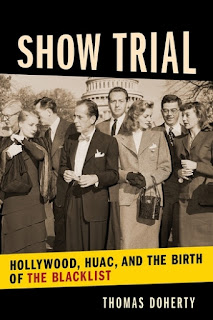 Cold War, Cool Medium: Television, McCarthyism, and American Culture; Hollywood’s Censor: Joseph I. Breen and the Production Code Administration; and Hollywood and Hitler, 1933–1939.
Cold War, Cool Medium: Television, McCarthyism, and American Culture; Hollywood’s Censor: Joseph I. Breen and the Production Code Administration; and Hollywood and Hitler, 1933–1939.Doherty applied the “Page 99 Test” to his new book, Show Trial: Hollywood, HUAC, and the Birth of the Blacklist, and reported the following:
Serendipitously enough, page 99 of Show Trial: Hollywood, HUAC, and the Birth of the Blacklist is not a random dip into the water but the source of a major current: the kick off to the long middle section of the book’s three act structure, the first page of the sixth chapter-- entitled “Showtime”—which chronicles the first day of the nine days of hearings staged by the House Committee on Un-American Activities in October 1947 to investigate alleged Communist subversion in the motion picture industry. The page tries to conjure the atmospherics in the hearing room and the media frenzy anent the hottest ticket in Washington, D.C., an attempt to evoke the sounds, swirls, and buzz in the white marble caucus room on the third floor of Old House Office building on Capitol Hill.Learn more about Show Trial at the Columbia University Press website.
To help with the paint job, I thought it might be useful to walk around the room where it happened. I got in touch with my local congressman, Seth Moulton, Democrat from the 6th district of Massachusetts, and set up an appointment with a couple of impossibly young and perky interns (really, they looked like eighth graders) to escort me to the caucus room which, near as I could tell, was pretty much the same as it was in 1947, when what was variously called “a three ring circus,” “a honkey tonk show,” and a “Grade A production in glorious Technicolor” was staged before the newsreel cameras and radio microphones. I walked up and down the whole room, mentally positioning the placement of the congressmen on the dais, the tables for investigators, witnesses, and press, and the 300 or so seats for the public, including a contingent of Hollywood artists known as the Committee for the First Amendment, who had flown to Washington to protests HUAC’s tactics. Towards the back of the room, far left as I entered, stars like Humphrey Bogart, Lauren Bacall, John Garfield, and Marsha Hunt had listened, rapt and disturbed, attracting more attention from the looky-loos than the actual witnesses. I didn’t feel déjà vu, because I knew I had been there before after a fashion, having looked so intently at the newsreel footage and photographs.
Page 99 might seem to be pretty long slog before getting to the main attraction—the hearings themselves—but the more I looked into the events of October 1947, the more I realized it was all about backstory: the 1930s, when the Hollywood Anti-Nazi League had rallied artists to the cause of anti-Nazism and pro-union activism; and World War II, when Hollywood and Washington engaged in the greatest alliance of government aims and media artistry in American history. The enduring legacy of the agitations of the 1930s and the martialing of Hollywood to military purposes during WWII was that movies—heretofore configured as pure escapism—were now seen as powerful transmission belts for cultural values and political ideology. In 1947, everyone--including the congressmen on the House Committee on Un-American Activities—knew that movies mattered.
The Page 99 Test: Hollywood and Hitler, 1933-1939.
--Marshal Zeringue



